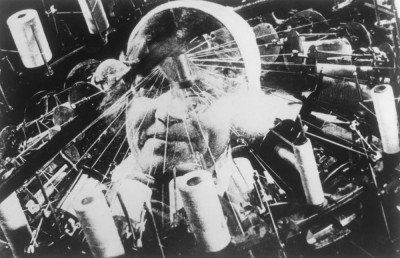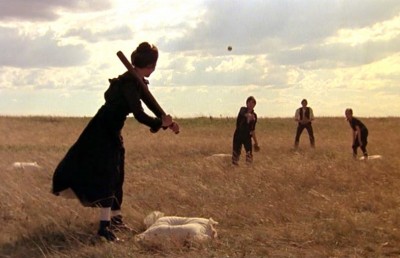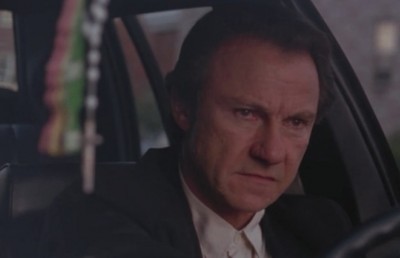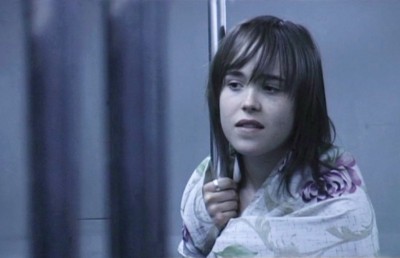Touch of Evil: A Cognitivist Approach
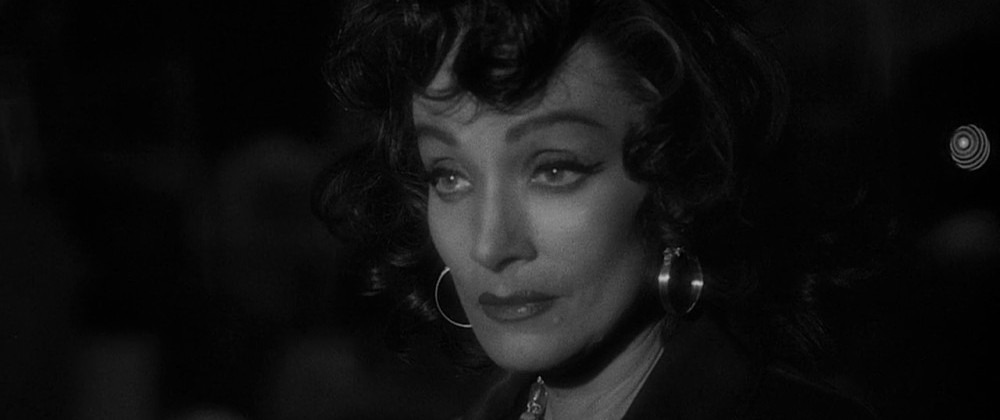
PROLOGUE
Much has been said of, written about, and analyzed in Touch of Evil (dir. O. Welles; 1958), the overwhelming amount of which is psychoanalytical, and to a lesser extent either social or historical. While relevant, these approaches still do not fully account for a work of such complexity, especially regarding spectatorship. As Carl Plantiga surmises, “psychoanalysis seems ill-suited to account for normative behavior such as perception, narrative comprehension, social cognition, and the experience of garden-variety emotions such as fear and pity.” Cognitive theory, however, is committed to clarity of exposition and argument and to the relevance of empirical evidence. Because of its firm grounding in cognitive science, cognitive film theory can also provide an inductive understanding of film spectatorship that can easily lend itself to teaching film production. This approach can be developed into a framework for understanding the information that may be revealed to the spectator from the filmmaker when the pro-filmic events and film form are juxtaposed. This cognitive framework is a natural level of exploration for a work such as Touch of Evil, precisely because the film’s pro-filmic events in juxtaposition with its film form produces what Stevan R Harnad calls “a revelation of a relation of resemblance that has some value” for the spectator. As I expose, these revelations do not arise by mere chance on the part of the spectator, but are willfully intended by the filmmaker. With my frame-by-frame analysis of Touch of Evil, I expose the cognitive schema from which affective appreciation arises in the spectator.
A common misconception in film analysis is that the camera is viewed as a window upon the events presented in the film – a device that simply records a pre-existent occurrence. The filmmaker’s rationale behind the placement of the camera in relation to the object recorded and the cutting from one shot to the next is generally assumed to be determined by the dramatic imperatives inherent in the event – if one character speaks and none of the characters are doing anything dramatically important, then move the camera in close to the speaker. If a group of characters is doing something, get them all into the shot. A change of shot comes with a change in dramatic focus – e.g. when one character stops speaking and another begins. At all points the event – the pro-filmic event – remains the centre of attention. This understanding of cinema, however, is severely limiting because it virtually precludes an understanding of the other components that formulate the cinema, namely the shot, montage and sound – essentially film form. The cinema is a medium that intrinsically appropriates other media as no other: like the novel, it can tell stories; like drama, it can portray conflict between live characters; like painting, it composes in space with light, color, shade, shape and texture; like music, it moves in time according to principles of rhythm and tone; like dance, it presents movement of figures in space and is often underscored by music; and like photography, it presents a two dimensional rendering of what appears to be three dimensional reality, using perspective, shading and depth. Given that all these elements are present in a work of cinema, it is not always the case that the pro-filmic events are the driving force of the film, although to the untrained eye this may be assumed. Luhr and Lehman are correct when they conclude, “to assume plot, characterization and dialogue (with the equally dubious assumption that they are the same in script and film) to be the essence of film is, quite literally, to ignore what you see and hear.” No one can deny that most films start with preexistent scripts. Further, it would be useless to dispute the fact that a film’s script generally contains the general direction that the story will take. But the script is usually completed before the actual filmmaking process begins – i.e. pre-production, production, post-production. Therefore, how integral can the script –a virtual catalogue of pro-filmic events– logically be to the understanding of the actual film?
At this point, a distinction should be made between autographic and allographic art. Nelson Goodman states that a unique notational system exists within allographic media, which suffers nothing through duplication and posits no integral relation to the original artifact. Allographic media are possible only insofar as they are amenable to a system capable of coding all the constitutive elements of the work. Notational language differs from discursive language in that each character in a notational system indicates one specific element: Precisely that and only that marks a compliance with the character. For example, in music, a particular key is one note and only one note. A specific movement can be performed precisely as it exists in the work by producing precisely the notes specified in the manner indicated. Similarly, in the theatre script the dialogue may be considered the notational instructions and the stage directions the discursive ones. The notational instructions are followed precisely and the discursive ones generally, and a performance of the work has taken place. Therefore, both Mozart’s Fortieth Symphony and Shakespeare’s Hamlet, for example, exist as fully realized works in their initial performances and in all succeeding performances. Thus, to analyze either Fortieth Symphony or Hamlet as a work, one must analyze the work as it was initially inscribed onto a written text, and not, for example, in a live performance.
In this respect, painting is an autographic art form because no notational system exists capable of reproducing a painting. Instead, painting is described in discursive language, and discursive language has large classes and not specific referents that comply with specific characters. As Luhr and Lehman make clear, no notational system has been developed enabling us to produce precisely, for example, the blue extent in the Mona Lisa, as blue points to a large compliance class. Because of this, the original, historical artifact is the only valid instance of the work. A copy, however good, is incapable of being the work. A sketch for a painting, for example, cannot be considered to have any integral relation to the completed work (although the sketch itself may be considered a separate work). The constitutive elements are different. However similar, a painting includes elements of texture, for example, simply not present in a sketch, and vice versa. Although a sketch may be used in the creation of a painting, perhaps even embodying certain conceptions of form the artist wishes to develop in his painting, but other constitutive elements enter in. The degree of a sketch’s utility in relation to the completed work – the painting – depends on individual circumstances. But a sketch for a painting is never a text of the painting.
Similarly, a film script is never the text of the film because, for example, the visual, audio (not dialogue), rhythmical, spatial, and textural aspects of a film cannot be legitimately verbalized within a notational system. A director may establish a dense text in which many elements other than narrative considerations evident in the pro filmic event determine the work itself. The pro-filmic event is not equivalent to the text; it is little more that a springboard for it. Therefore, the script, either original or based on source material, is not a given – it is only one of innumerable but equal elements, and the screenwriter(s) one of innumerable but equal collaborators, that converge in the creation of a film under the guidance and authority of the director, or cinematic author. These conceptions have become institutionalized among a majority of filmmakers, film critics, and filmgoers. It has frequently been referred to as the Hollywood “invisible style” –a style whose goal is to make any mediation between audience and filmic event “invisible”. This is an ironic term since many “Hollywood” films completely avoid this “invisible” style, while a great many European “art” films, and “independent” films are guilty of such “invisible” stylistics. Awareness of the existence of the camera is considered detrimental to the pro-filmic narrative of the film. A central element in this style is what is commonly called the shot-reverse-shot method of editing. This method of editing entails shots created on the principles of interaction within the pro-filmic event.
This view of the cinema virtually precludes the very possibilities of filmmaking by reducing many important elements to little more than window dressing. The camera can be much more than a window. In the hands of challenging filmmakers it is essential not to the recording but to the very construction of the scene. The most challenging films are actually constructed on composition; on the integral relation of the camera to the object it records. Many complex formal elements can determine where the camera is placed, when it moves, when a cut takes place, and so on. Ultimately, in a carefully constructed film, the pro-filmic event is little more than an abstract conception, there is an implicit understanding of the specific film form elements that construct the events and their relevance they have to the overall design of the film. As I hope to establish with my analysis, Touch of Evil is a most challenging work of cinema precisely because of the interplay between the pro-filmic events and film form.
A cognitive approach can reveal the varied and interwoven series of formal strategies, which can, for example, emphasize, enrich, mock, suggest and/or anticipate the pro-filmic events (or vice versa) of Touch of Evil. Foremost, there is a different formal “strategy” used with regard to every main character (or, indeed, vice versa). A sampling of six formal strategies will suffice for the purpose of this introduction: Quinlan, Vargas, Pete, Suzy, Tana, and the Joe Grandi (and his fellow thugs).
ANALYSIS
Quinlan and Vargas are two sides of the same coin; they are therefore presented thusly: each is photographed at a low angle, both characters dominate any group shots and when there are scenes involving many characters, only Vargas and Quinlan are allocated prestigious single shots. Throughout the entire film, these unique visual strategies are exclusively reserved for Quinlan and/or Vargas, and no other. Therefore, if one were to only analyze the way in which their scenes are presented, one would rightly conclude that both characters are leaders, both have strong personalities, and both are equals to no other but themselves –which is, of course, entirely correct as the pro-filmic events reveal. Moreover, because these two characters undergo changes over the course of the film, their “presentations” metamorphose accordingly. And if Welles wishes to formally stress a character’s inner feelings or thoughts, he does so, but never at the cost of breaking his calculated visual strategies.
Quinlan’s entrance scene and his introductory meeting with Vargas are prime examples of how Welles applies his formal strategies while incorporating one character’s feelings and another’s thoughts. Wishing to accentuate the fact that the Quinlan and the Americans view Vargas solely as a “Mexican” and that, consequently, Vargas feels he is an “outsider,” Welles presents the scene duly: Quinlan’s introductory shot is the distinct low angle, single shot. Next, in a succession of low angle shots, Quinlan greets the D.A. and other fellow officers. Quinlan, at the centre of every shot, dominates every shot. Then, in a single, low angle shot, Vargas approaches Quinlan (note the apt tourism billboard behind Vargas which proclaims “Welcome Stranger!” in bold-type). Quinlan is clearly irked by Vargas’ presence, provoking a heated verbal exchange: Vargas is framed alone, visually stressing that he will be a lone crusader against Quinlan’s machinations; Quinlan is framed with his cronies, visually implying an “us-against-you” attitude without overtly stating such a fact. The scene ends with two quick glances –perhaps snarls are more appropriate– shared between Quinlan and Vargas: two low angle, single shots that reaffirm their positions within Welles’ visual strategies.
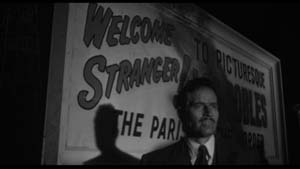
The point at which Welles’ visual approach for Vargas and Quinlan loses its equilibrium occurs after the dynamite is discovered in the hotel room. Because Vargas himself had earlier mistakenly dropped the shoebox in question –the once-empty shoe box that now miraculously contains the two sticks of dynamite needed to convict the Mexican shoe clerk– he, like the viewer, is now rather inclined to believe Quinlan planted the required evidence. And now that Vargas, along with the audience, is convinced that Quinlan is a fraud, Welles accordingly adjusts his visual strategies. Never again will Quinlan receive the designated single, low angle shot, nor will he dominate any group shots. Welles will continue to frame Vargas, on the contrary, in the same manner that he has always photographed him. Welles’ intent is subtle while remaining explicit: Quinlan is not a true leader, his strong personality is based on a complete falsehood, and he is secondary to Vargas’ true nature. Note, however, that Welles allows Quinlan one last single, low angle shot at the end of the film: when Quinlan starts to get a (correct) feeling that Pete is lying to him, he then starts to (correctly) believe Pete is being bugged by Vargas. The reason Welles allows such a distinctive visual trait to resurface at this point in the film is to emphasize Quinlan’s instinctual side, which, unlike his ethical side, is completely intact.
An exemplary scene in which Welles realizes a character’s internal angst is the scene in which Joe Grandi proposes a deal to Quinlan whereby they would both frame Vargas, thus ridding both men of their immediate troubles. The scene commences with Joe bringing two bourbons to a table where he is sitting with a very drunk and very miserable Quinlan. The shot dollies back and to the right, following Joe as he walks to their table, where the camera finally settles upon a seated Quinlan, who seems squeezed into the frame. In truth, the way Quinlan is framed makes him seem almost physically uncomfortable, as the table nudges beneath him, while the (actually) sagging ceiling gives the impression that it will soon give way and squash everyone at any moment. After Joe finishes answering a phone call, he orders two more double bourbons. The shot then cuts to a high angle shot of Joe and Quinlan from a high angle and then continues to slowly boom upwards, the effect of which simultaneously makes the smallest character in the film seem much larger than the largest character in the film! As the camera begins to to boom upwards, making Quinlan smaller and smaller, Welles ironically has Joe say, in reference to the drinks he has just ordered, “Make ‘em big!” This scene, while quite meaningless in its dialogue, formally conveys the meaning of the scene.
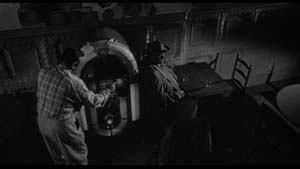
For Pete, Quinlan’s loyal friend and fellow officer, Welles again fashions a formal strategy. From the beginning of the film until, again, the pivotal hotel scene where Vargas presumes Quinlan to be a fraud, Pete is never given a single, low angle shot, nor does he dominate any group shots. He is, in fact, treated in the complete opposite fashion, like all the other indistinguishable characters that populate Touch of Evil. However, once Vargas plants the seeds of doubt concerning Quinlan, Pete has no other choice but to a least question Quinlan’s ethical validity as an officer of the law. As the film progresses and the evidence against Quinlan mounts, what is remarkable about the formal strategy Welles fashions for Pete is that he is gradually given more and more prestigious single shots, thus formally stating that Pete is beginning to break away from the mundane thinkers that populate innocuous members of the group shot, and that he is beginning to think for himself. There is a remarkable shot where in addition to making the aforementioned formal point with Pete, Welles also emphasizes Quilan’s evaporation as a respected and influential individual in society. This shot occurs after Vargas accuses Quinlan of falsifying evidence, when Pete approaches Quinlan who, in a moment of weakness, is being led away from the hotel by Joe Grandi. For the first time in the film, Quinlan snarls at Pete (to go back into the hotel and gather more evidence). Since Pete, and the audience, know that Grandi is a thug, why, the audience asks itself, would Quinlan associate with him? The feelings of suspicion and disappointment that this question arouses within Pete (and, concurrently, the audience) is vividly conveyed in one shot: the camera is outside a the hotel window looking in on Pete, who is screen right in a close-up (for the first time), while on the window glass the reflection of Quinlan being led away by Grandi appears screen left (this, concurrently, also marks the first time Quinlan does not dominate a group shot). Special attention must be given to the fact that while Pete is granted single shots as he becomes more self-confident, he fails to stand alone as a true independent, therefore he is not allocated any low angle shots, nor does he dominate any group shots within Welles’ overall formal strategy.
Welles amusingly mocks the Grandi thugs by denying them low angle, single shots, nor are they allowed to dominate any group shots. Whenever the Grandis are in the presence of Vargas, Quinlan, or any other character –with the exceptions of Suzy and the Night manager at the Grandi hotel– they fail miserably in generating any sense of intimidation, let alone domination. Such examples abound throughout the entire film, from Joe Grandi cowering in both Quinlan’s and Vargas’ presence in the hotel scenes (before Quinlan is unmasked as a fraud) to the scenes where Vargas has to physically deal with the Grandi boys (e.g. the acid-throwing scene near the film’s opening or the bar-room brawl scene that Vargas starts near the film’s conclusion). However, when the Grandis are amongst themselves, or threatening Vargas’ fragile, virginal wife Suzy, and the demented, child-like Night Manager –who, for one reason or another, seems perpetually frightened– Welles amusingly lets them adopt all of the formal attributes associated with Vargas and Quinlan. Note, for instance, the manner in which Welles introduces the pivotal character of Joe Grandi: a low angle, single shot, not unlike Quinlan’s earlier debut. However, as the scene unfolds, the audience realizes that Joe Grandi is not only shorter than Suzy, but that he is the smallest person in the film! Welles then denies him any more single, low angle shots, nor does Welles allow him to dominate any of the numerous group shots that form the scene. On the pro-filmic level, this mockery of Joe Grandi is complimented when Welles has him say to Suzy in a threatening manner, “D’you know who I am?” while looking into a mirror and adjusting his appearance, as if he were a major threat to be reckoned with (when in actuality he seems to be “doing” an impression of either James Cagney’s or Edward G. Rosinson’s many famous gangster impersonations). Joe Grandi’s foolishness is so explicit that at one point even Suzy, exasperated, must exclaim, “You know what’s wrong with you, Mr. Grandi? It’s that you’ve been seeing too many gangster movies!” Naturally, Joe Gradni replies, nearly impersonating Cagney, with a threatening, “Yeah?” to which Suzy, none too threatened and “doing” a much better Cagney, snaps back, “Yeah!” Nevertheless, just because Joe Grandi is foolish with all his gangster rhetoric and mannerisms, he still is a dangerous gangster –a fact that Suzy fails to realize. (Welles, in speaking with Peter Bogdanovich, refers to Joe Grandi as “a comic heavy.”) Keeping Suzy’s ignorance of gangster life in mind, one understands why this scene is the only scene she will ever “dominate” in the entire film. (Note the flickering light throughout this scene. This light pattern acts as a foreshadowing device, as it will reappear when Quinlan murders Grandi. Ironically, Grandi is the threatening individual in this scene, and then later, when the flickering light will reappear, he will be the threatened individual.)
An aura of mystery and melancholy shrouds Tana (Marlene Dietrich), Quinlan’s old friend from his long, lost past. Quinlan visits Tana twice during the entire film, once at the beginning and once at the end, and both times he is presented in the same peculiar manner –quite contrary to the visual strategy Welles applies to him throughout most every other scene. Before Quinlan first enters Tana’s environment, he seems quite independent and domineering, which is, of course, accentuated by Welles’ use of the low angle, group shots in which Quinlan dominates all others, plus the prestigious single shots. Yet, when he visits Tana on both occasions, these formal characteristics completely evaporate. Although Welles continues to photograph Quinlan with the single shots, every room in Tana’s setting simply dwarfs him! Furthermore, he seems anything but intimidating. Perhaps pitiful may be too strong an adjective, but he definitely seems vulnerable. As their first scene together develops, Quinlan momentarily sheds his trademark scowl, and instead whispers and mumbles while sucking on a candy bar. In addition, Tana speaks to Quinlan without a hint of intimidation and with such absolute frankness –which no one else ever does: “You’re a mess, honey,” she says to him at one point. Welles formal strategy for Tana is most revealing: she is the only character photographed with soft light, which is quite dissimilar to the high contrast lighting that characterises the rest of the film’s lighting schema. This, accordingly, completely distinguishes her quality as a unique character. And when Quinlan returns to visit her later in the film, after he has been accused of fraud by Vargas, we realize that Tana can read one’s future by reading cards. Quinlan, drunk and depressed, demands, “Read my future for me!” Tana, without blinking, confesses, “You haven’t got any…you’re future’s all used up.” And we believe her. The bond Tana and Quinlan share is, of course, something akin to a sixth sense: his being the inborn ability to discern a guilty man from an innocent (what he calls “intuition”) while hers being the ability of a mystic, to read one’s future. Note, for instance, that Tana appears from nowhere at Quinlan’s death. One must ask the inevitable questions: How did she know where Quinlan would die? How did she know when Quinlan would die? The answer, while steeped in mystery, is made discernable if one understands the formal strategies of her earlier scenes with Quinlan.

Possibly one of the most intricate formal strategies Welles integrates into his film is the one he uses to distinguish Suzy. From her first scene away from Vargas until she is finally physically assaulted by the Grandi thugs (which include, most disturbingly, women), Welles photographs her in such a manner that can only be properly described as “cinematic assault.” In every scene where Suzy appears without Vargas, she is visually trapped within the shot in which she appears. The camera never tracks Suzy for the purpose of following her, but for the purpose of trapping her. In her first scene away from Vargas, for example, she is walking towards her hotel. As she walks through the crowded streets, the camera swiftly pans right and abruptly stops –not on Suzy, but on Suzy’s attacker– a Grandi thug, who is already eyeing her predatorily. This camera movement, common only to Suzy, is remarkable. With it, Welles subtly communicates that Suzy cannot escape the imminent threat brought forth by the Grandi family. As the scene is played out, one notices another startling formal signature solely attributed to Suzy: all her shots, aside from the eerie track shots previously mentioned, involve cage-like static shots. Or, more precisely, the camera takes on the characteristics of a thug whenever Suzy is on screen. For example, as she is accosted by the Grandi thugs and must maneuver her way around them, Suzy, therefore, must maneuver her way around the static camera shots. Thus, to escape a thug (the camera shot), she walks out of his way (out of the camera shot’s field of view). Accordingly, the following shot has Suzy entering a static camera shot (entering a thug’s eye sight). The remainder of her scenes all relate to this very basic, but clever, formal strategy. In Suzy’s very next scene, for example, the very same track shot identified earlier is used again (after she meets Joe Grandi). Wanting to further enhance Suzy’s impending doom visually, Welles always has someone –and not only a “bad guy”– intrude upon her privacy. Recall, for instance, the scene where Suzy is in her hotel room changing her clothes, and a Grandi thug shines a flashlight on her through her a window from an adjoining building; the scene where Suzy first enters her room at the Grandi hotel: a low angle shot is taken from inside the room, with Suzy entering at screen right. If one blinks for but an instant, one would miss the hapless Night Manager peering through her window at screen left; or the scene where Suzy tries to get some sleep, but cannot because the Grandi thugs are blaring music into her room through a telecom system.
This brief, admittedly as-yet incomplete analysis demonstrates how complex a film Touch of Evil is on a purely cognitive level, how completely detailed and precise every shot has been staged, photographed and edited in accordance to all the major characters’ personalities, thoughts and/or feelings. I am far from completely conveying all of the formal information Welles clearly intended us, as an audience, to digest. What remains most disturbing, on the other hand, is the fact that Welles himself, not to mention every other artist, craftsman and technician who worked on this film have never overtly acknowledged the fact of these formal strategies that is incontestably the fabric of this film. Without their detailed input everything I have written, all of the theories that I have brought forth, are based on my complete assumption that they were intentional acts by Welles. I admit, of course, that I may be incorrect. Perhaps I am reading “into” this film, as have so many others read “into” so many other films. The following exchange, however, between then-neophyte filmmaker Peter Bogdanovich and Welles may reveal more than at first appears about Welles’ cognitive leanings as a filmmaker: “How do you decide where you’re going to put the camera?” Bogdanovich asked. “I don’t make a conscious decision –I know instantly where it goes. There’s never a moment of doubt,” Welles answered. “You look through the camera when it’s set up?” persisted Bogdanovich. “No,” affirmed Welles, “I place my hand where the camera goes and that’s it. I never move it. I know exactly where it’s going to be…I think I share with Hitchcock the ability to say what lens goes in the camera and where it stands without consulting a viewfinder or looking through the camera.” Dumbfounded, Bogdanovich persisted, “Why did you put a blind woman in the scene where Heston [Vargas] is telephoning his wife?” Exasperated, Welles replied, “There isn’t anything to add to what’s on the screen. There is the kind of director who wants to explain, but I haven’t anything to say,” concluded Welles. “Why did you make her blind?” demanded Bogdanovich, still not satisfied. “Why not? I know that sounds uncooperative, but I’m just absolutely flummoxed by those sorts of questions, I don’t have a reply. If I were standing before the pearly gates and I had to tell why she was blind, I’d be stuck for an answer. I wasn’t signaling something to the audience with it. I never am,” the filmmaker answered in all honesty. The interviewer then handed him a fifty-eight-page memo originally written to then Universal Pictures C.E.O. Ed Muhl. Welles signed the memo himself. Apparently the memo was written after Welles had witnessed a terrible rough-cut screening of Touch of Evil that the studio had put together without his consent. (Welles had been kicked out of the editing room for being, of all things, too obtrusive in the completion of his own film!) One small paragraph concerning the blind woman in question, reads as follows:
In the scene in the blind woman’s shop, I note with distress that the shot of Vargas at the telephone has been blown up [enlarged] in such a way as to eliminate the blind woman in the foreground. She was not there by accident. Her presence embarrasses Vargas and inhibits his phone conversation with Susan. This provides a curious note of minor tension which will be missed. Susan in the strange motel speaking with drowsy sexiness to her husband in the even more strange shop of the blind; his discomfort at the quiet, oddly attentive figure of the blind woman –these were elements in a rather carefully balanced little plan. It seems a shame to disrupt this simply because it struck someone that the woman sitting there is the foreground was rather peculiar. It was meant to be peculiar. If the dialogue between Susan and Mike was more significant, if vital [pro-filmic] plot points were being established, then, of course, the blind woman would be quite the wrong sort of distraction. As it is, she lends a special dimension to a scene which, on the face of it, advances our story not at all and must be perfectly routine.
Astonished, interviewer Bogdanovich gasped, “Why didn’t you give me that answer?” “That’s what you tell Eddie Muhl,” responded Welles with most embarrassment, “not Pierre di Bogdanovich.”
EPILOGUE
Thanks to Noël Carroll and David Bordwell’s polemics in film theory circa the 1980s, “psychosemiotic” theory is no longer accepted as the sole approach to cinema studies. In fact, the history of film theory demonstrates that there is a long tradition of analysis – notably the works of early film theorists like Eisenstein– regarding the psychological effects of film viewing other than psychoanalysis. Recently, cognitive film theory has come to encompass a wide spectrum of enquiries, such as non-fiction film (Plantiga), the avant-garde (James Peterson), and film spectator psychology (Gregory Currie), among many others.
However, cognitivist theory is still dismissed by some, including Robert Stam, as “a nostalgic move backward to a world prior to … Lacan’s destabilized ego, prior to Marxist and Freudian critiques of ‘common sense.’” Regardless of Stam’s argument, he fails to appreciate the intrinsic value of a cognitivist approach: reproducibility. This leads, of course, to the possibility of further empirical development. A psychoanalytical approach to narrative cinema –while fruitful for individual analysis– lacks a systematic approach, thus severely limiting its applicability. Again, as Plantinga clarified, cognitive film theorists do not oppose psychoanalysis per se –but are instead committed to clarity of exposition and argument, and to the relevance of empirical evidence and the standards of science (where applicable).
A most promising field of inquiry is Jerome Bruner’s constructivism. He claims that people actively participate in the shaping of their reality. Specific frames of reference called “cognitive schemas” develop from experience, and are used to make sense of new experience. These schemas shape what is perceived, and thus guide understanding and emotion. These schemas are analogous to the aforementioned preparation the viewer must undertake before a comprehension of the elements of narrative film may occur. I intend to characterize this cognitive schematic framework in accordance with Bordwell’s constructivist theory regarding film narrative and his analysis of its relation to the formal workings of film.
The criticism that cognitive theory may be unable to deal with the elicitation of emotion in cinema deserves further investigation. Recent work in psychology has firmly situated the emotional response within a cognitive theoretical framework. In order for affective factors to develop from a sensation to an emotion, a knowledge system is required. While film theorists –notably Carroll– have made attempts to develop the relation between cognitive and affective components in film spectatorship from a cognitive perspective, further work is required. Working from their assumption that emotions depend in part on an understanding and appraisal of knowledge, I believe a cognitive schema of narrative film comprehension is possible, containing therein a basis for affective judgment.
The general meditation that runs through much of my filmmaking and theoretical research concerns the possibilities of cognition via what Goodman terms autographic and allographic art forms. I am especially interested in what I believe to be the fundamental tension that exists within the narrative cinema, specifically the paradigms related to presentation, including:
• The pro-filmic event versus film form.
Theoretical problems associated with autographic and allographic art forms include:
• Notational Systems versus Discursive Language.
• Sensuality versus Intellectuality.
• Exclusiveness versus Inclusiveness.
• The Possibility of Duplication versus the Impossibility of Duplication.
• Relative Concepts versus Absolute Concepts.
As evidenced by the varied and interwoven examples of formal strategies of Touch of Evil, a cognitive approach indeed can lead to a more thorough understanding of the film experience of the spectator. This more thorough understanding is ideally suited for teaching film production, because it can be used to express what cinema can do formally vis-à-vis the filmmaker’s willful intent for the spectator. The presentation of these characters via film form is not arbitrary or coincidental, but willfully chosen by the filmmaker to communicate specific thoughts and feelings in juxtaposition to the pro-filmic events – resulting in an enhancement of the experience of the film as a whole.
Author’s Note
Please be advised that the analysis contained herein is admittedly incomplete, and should therefore be treated as such. This is a work-in-progress. A complete analysis is forthcoming. Until then, this may serve as a mere introduction.
BIBLIOGRAPHICAL REFERENCES
Anderson, Joseph. The Reality of Illusion: An Ecological Approach to Cognitive Film Theory. Carbondale, Southern Illinois University Press, 1996.
Bazin, Andre. What Is Cinema?: Volume 1. Berkeley and Los Angeles: University of California Press, 1967.
Bordwell, David. Making Meaning: Inference and Rhetoric in the Interpretation of Cinema. Cambridge, Harvard University Press, 1989.
Bordwell, David and Noël Carroll (eds.). Post-Theory: Reconstructing Film Studies. Madison, University of Wisconsin Press, 1996.
Branigan, Edward. Narrative Comprehension and Film. London and New York, Routledge, 1992.
Bruce, Vicki, and Patrick R. Green. Visual Perception: Physiology, Psychology and Ecology. Hove, Lawrence Erlbaum Associates, 1990.
Bruner, Jerome. Actual Minds, Possible Worlds. Cambridge: Harvard University Press, 1986.
Buckland, Warren. The Cognitive Semiotics of Film. Cambridge, Cambridge University Press, 2000.
Carroll, Noël. Theorizing the Moving Image. Cambridge, Cambridge University Press, 1996.
Chomsky, Noam. Aspects of the Theory of Syntax. Cambridge, MIT Press, 1965.
Cowen, Paul S. “Manipulating Montage: Effects on Film Comprehension, Recall, Person Perception and Aesthetic Responses” (1991), Empirical Studies of the Arts, vol. 6, no. 2, 1998, p. 97-115.
Cowen, Paul S. “Visual Memory, Verbal Schemas and Film Comprehension” (1992), Empirical Studies in the Arts, vol. 10, no. 1, 1992, p.33-35.
Currie, Gregory. Image and Mind: Film, Philosophy, and Cognitive Science. Cambridge, Cambridge University Press, 1995.
Eisenstein, Serguei. The Film Form. New York, Meridian, (1949) 1957.
Eisenstein, Serguei. The Film Sense. New York, Harcourt Brace Jovanovich, (1942) 1975.
Goodman, Nelson. The Languages of Art. Indianapolis: Bobbs Merrill, 1968.
Gibson, James J. The Senses Considered as Perceptual Systems. Boston, Houghton Mifflin, 1966.
Heath, Stephen. “Film and System, Terms of Analysis” Part II in Screen vol.16/N°2, Summer 1975, p.91-113.
Harnad, Stevan R (ed.). Categorical Perception: The Groundwork of Cognition. Cambridge, Cambridge University Press, 1990.
Luhr, William, and Peter Lehman. Authorship and Narrative In the Cinema. New York, G. P. Putnam’s sons, 1977.
Perterson, James. Dreams of Chaos, Visions of Order: Understanding the American Avant-Garde Cinema. Detroit, Wayne State University Press, 1994.
Perkins, V. F. Film As Film. London (UK): the Penguin Group, 1972.
Plantinga, Carl and Greg M. Smith (eds.). Passionate Views: Film, Cognition, and Emotion. Baltimore, John Hopkins University Press, 1999.
Stam, Robert, Robert Burgoyne and Sandy Flitterman-Lewis. New Vocabularies in Film Semiotics: Structuralism, Post-Structuralism, and Beyond. New York, Routledge, 1992.
Wilson, Robert A., and Frank C. Keil (eds.). The MIT Encyclopaedia of the Cognitive Sciences. Cambridge, MIT Press, 1999


